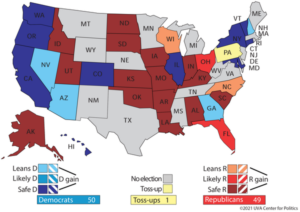It’s now clear that killing the filibuster altogether is a non-starter, since several Democratic senators have already expressed opposition to the idea or are skeptical about it. The other non-starter is doing nothing, which would limit the potential accomplishments of the Biden Administration. Michael Ettlinger, founding director of the Carsey School of Public Policy at the University of New Hampshire discusses five alternative measures for filibuster reform at Vox. The first two proposals include,
1) The “Mr. Smith Goes to Washington” rule
The current filibuster rules don’t require senators to hold the floor with uninterrupted oratory — the popular idea of a filibuster — to block action. If senators had to keep speaking to forestall a vote, gridlocking the Senate, it would make filibusters more painful and hence, presumably, less frequent. The bills that centrist Democratic senators most fear are those that Republicans most strongly oppose and would probably be blocked. Other needed legislation would, however, have a better chance.
2) 41 to block, instead of 60 to pass
Flip the way the Senate does business: Instead of requiring 60 votes to proceed on a bill, require 41 (or more) votes to block it. A bill could advance with a simple majority unless 41 senators were at hand to vote “no.” This would require 41 opponents to stay close to the Senate floor lest the bill slip through when their numbers are below the blocking threshold.
Both of these approaches are based on making the filibuster more of a hassle for senators and take time away from other work. Also, they may not work anyway, since the filibustering party should be able to find enough senators to hang around and obstruct the legislation. But the next three reform proposals Ettlinger discusses should have more appeal. They incude:
3) More exceptions to the filibuster rule
There are currently exceptions to the 60-vote requirement for budget reconciliation and, as of recently, presidential nominations. More exceptions could be added. The benefits of this approach, and the level of support for it, would depend on the breadth of the exceptions. Exceptions that have been suggested include votes to raise the debt limit, expand voting rights (HR1, for example) or fund the federal government.
This approach could also be tailored to deal with very specific concerns of senators; there could be an exception, for example, for “legislation that expands access to health care.” Another possibility would be to allow majority votes on statehood to make it possible for the District of Columbia and Puerto Rico to gain representation. Ad-hoc exceptions are an inelegant approach, but might be necessary.
4) Overcome the filibuster with a vote in two Congresses
Allow passage of bills that can currently be filibustered when a simple majority supports the legislation in two successive Congresses, with an intervening election. A number of states similarly require votes in successive legislative sessions for advancing state constitutional amendments. This approach would allow the will of the Senate majority to be expressed, ending the ability of a minority to perpetually block legislation, but with an opportunity for opponents to make their case, and voters to intervene.
This approach would also create an incentive to pass compromise legislation without waiting for the second vote: Each side has something to gain by coming to an agreement that provides the 60 votes needed for one-session passage in exchange for changes in the legislation. It would still be very hard to pass legislation, but a persistent, election-tested, majority could accomplish its goals, even in the face of a committed opposition.
5) Lower the filibuster threshold
The number of votes needed to break a filibuster was previously reduced from 66 votes to 60. It could be further reduced. If one thinks that there are Republican senators who might break from their party to support some Democratic priorities, reducing the threshold to 52 or 53 votes would address the concern of passing legislation with no Republican support, while not requiring more than the couple of centrist Republicans to join.
Yes, yes and yes — these are all good ideas. It should be possible to get Democratic senators who oppose killing the filibuster to support some combination of these three alternatives, with a little arm-twisting and positive inducements, if needed.




